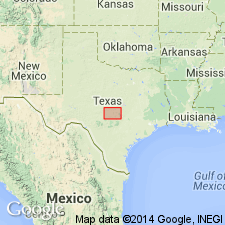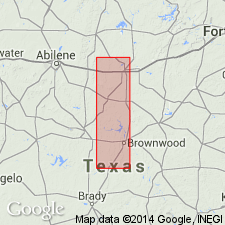
- Usage in publication:
-
- Speck Mountain limestone bed
- Modifications:
-
- Original reference
- Dominant lithology:
-
- Limestone
- AAPG geologic province:
-
- Bend arch
Summary:
Pg. 387, 408. Speck Mountain limestone bed in Cisco division. Massive dark rough-weathering limestone, 3 to 5 feet thick, well developed on top and to west of Speck Mountain. Northeast of Rockwood consists of 5 feet of hard massive white limestone, and near Trickham of 2 to 4 feet of white barren, rather friable limestone. Member of Cisco division [Cisco is 2nd from top of 5 Carboniferous divisions of Cummins, 1891]. Overlies Speck Mountain clay bed and underlies Lohn bed. Age is Pennsylvanian.
[Named from Speck Mountain, Coleman Co., Colorado River region, central TX.]
Source: US geologic names lexicon (USGS Bull. 896, p. 2038).

- Usage in publication:
-
- Speck Mountain limestone [member]
- Modifications:
-
- Revised
- AAPG geologic province:
-
- Bend arch
Summary:
Speck Mountain revised--called Speck Mountain limestone [member] and assigned to newly named Thrifty formation of Cisco group (revised). In Brazos River Valley Thrifty formation is divided into following members (ascending): Avis sandstone; unnamed limestone, unnamed shale and sandstone; Ivan limestone; unnamed shale and sandstone; Blach Ranch limestone; unnamed shale; and Breckenridge limestone. Divided in the Colorado River Valley into following members (ascending): unnamed shale, sandstone, and limestone; Speck Mountain limestone; unnamed shale, sandstone, and limestone; and Breckenridge limestone. Speck Mountain is present in a section measured in Brown Co, TX on Bend arch. Correlation chart. Pennsylvanian age.
Source: GNU records (USGS DDS-6; Denver GNULEX).

- Usage in publication:
-
- Speck Mountain limestone member*
- Modifications:
-
- Biostratigraphic dating
- AAPG geologic province:
-
- Bend arch
Summary:
Speck Mountain member of Thrifty formation of Cisco group (Blach Ranch limestone member of the Brazos River drainage basin). Consists of greenish- to yellowish-gray fine calcarenite with a shaly parting near the middle. Thickness up to about 8 feet. Separated from overlying Breckenridge limestone member by 22 to 34 feet of shale with minor amounts of sandstone. Fusulinid fauna characterized by TRITICITES PLUMMERI Dunbar and Condra, 1927, DUNBARINELLA sp., and SCHUBERTELLA sp. Age is Late Pennsylvanian.
Recognized in Coleman, Brown, Eastland, and Stephens Cos., central TX.
Source: Publication; US geologic names lexicon (USGS Bull. 1200, p. 3680).
For more information, please contact Nancy Stamm, Geologic Names Committee Secretary.
Asterisk (*) indicates published by U.S. Geological Survey authors.
"No current usage" (†) implies that a name has been abandoned or has fallen into disuse. Former usage and, if known, replacement name given in parentheses ( ).
Slash (/) indicates name conflicts with nomenclatural guidelines (CSN, 1933; ACSN, 1961, 1970; NACSN, 1983, 2005, 2021). May be explained within brackets ([ ]).

